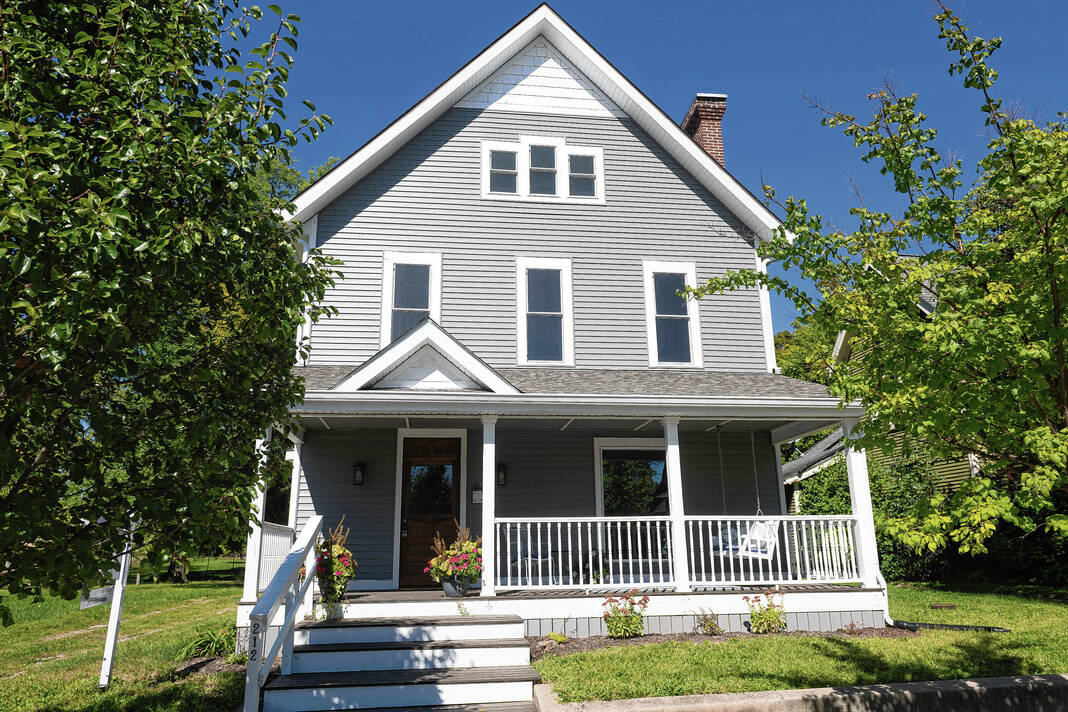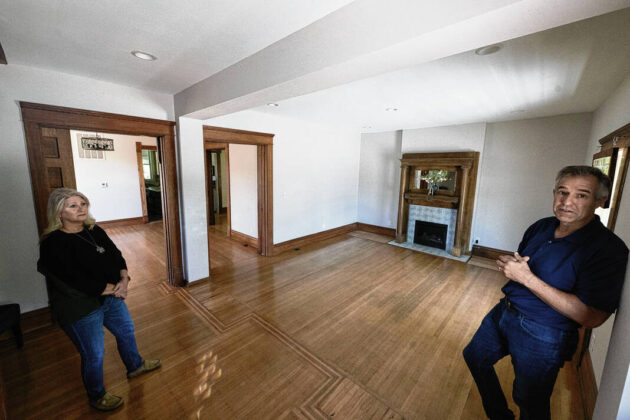GREENFIELD — Greenfield Historic Landmarks held its annual Preservation Awards on Sunday, commending local homeowners and two local businesses for preserving, beautifying and saving historic properties.
Greenfield city planner Joanie Fitzwater was also recognized for her successful push to win a multi-million-dollar Stellar Grant for the community, which has since funded a number of historical renovation projects throughout the city’s historic downtown district.
David and Rhonda Schrank were the first to be recognized at Sunday’s award ceremony, held at ‘Lizabuth Ann’s Kitchen at the James Whitcomb Riley museum.
GHL board member Marciann McClarnon-Miller called the Greenfield couple her “heroes” for restoring her childhood home at 212 E. North St., which sits two blocks east of State Street.
“This was a great home to grow up in,” said McClarnon-Miller, who shared a bit of history about the home.
“In 1950, my great-grandmother bought it for my parents because I was on the way,” said the lifelong Greenfield resident, who was heartbroken to see the home fall into disrepair over the years.
“These two are my heroes here because they saved it,” she said, commending the Schranks on Sunday.
The couple retrieved some priceless family heirlooms from the home and returned them to McClarnon-Miller, whose father Keith McClarnon was mayor of Greenfield from 1976 through 1995.
First-time homeowners Brandon and Luaren Lavy were also presented with a Residential Preservation Award on Sunday.
The couple are still renovating the home at 234 W. Main St., which was built in 1861.
“It was built around the time U.S. 40 was being built, so a lot of homes like ours had side porches where people could still enjoy being outdoors away from the dirt and the smell and the noise out front where the road was being built,” said Lauren Lavy, who admitted being hesitant when her husband wanted to purchase and restore the historic home.
“The kitchen was 6 inches off the foundation,” he recalled with a grin.
The couple said hostesses from the Riley home and museum, just three doors down, would often stop by and share a bit of history about the home.
Michael and Kathleen Ball were honored for remodeling their 19th century home at 515 N. State St., a Folk Victorian built in 1893. Among the many renovations the couple made to the home was replacing over 28 windows, many of them over 7-foot tall.
“Restoring an old house takes grit, it takes courage, it takes dedication, but this has been a labor of love for us,” said Michael Ball, as he shared stories about the home’s architecture and history with the crowd gathered Sunday.
“They used to drive an ice wagon down the alley out back, and kids would chase after it hoping to catch a piece of ice,” he shared.
Robert Sutton also shared some bits of history about the house he and his wife Carrie extensively remodeled on CR 350 North, earning the couple a Rural Preservation Award from GHL.
The 172-year-old house — built in 1850 — belonged to Sutton’s grandparents. He and his wife got it in 2018, two years after his grandmother died.
In a slideshow Sutton showed a picture of a young boy and girl standing in front of the home. The girl was Sutton’s mother, who was with her son at Sunday’s awards ceremony.
Sutton said the home was built entirely out of bricks made onsite with materials found on the property, and wood from trees on the property.
He and his wife transformed the white brick home into a more modern yet historic navy blue farmhouse, replacing the stately arched windows and doors across the front of the home with historical replicas, and adding a sloped roof and front porch.
“We added two walls but tried to keep it just as it was as much as we could, and we were able to save 80% of the floors. We try to make sure that when we make changes we do it right,” he said.
In addition to the residential preservation awards, the Hancock County Commissioners received an award for work done to the Hancock County Memorial Building, which was dedicated in 1924.
McClarnon Miller shared that the memorial building was always beautiful to look at on her walk to school, and that many Greenfield natives enjoyed attending high school dances there.
Two local businesses were also presented with Adaptive Reuse Awards on Sunday.
Brooke Palmer was recognized for moving her State Farm Insurance agency into a 1860 Gothic Revival house at 226 W. Main St., which previously housed the former home of Willowes’ Basketry and Yarn Haus.
Landmarks board member Tom Strickland commended Palmer for her diligence in working with the state’s historic board to select historically accurate paint colors when painting the outside of the building.
Sara and Tom Joyner, who own Joyner Homes, were presented an Adaptive Reuse Award for purchasing and repurposing the former First Presbyterian Church at 116 S. State St., right next door to their main office at 123 W. Main St.
The Joyners were considering converting part of their warehouse into office space when they found out the church was available, so they purchased it in late 2020. “We thought it was the perfect fit for us,” Sara Joyner said at the time.
The former church now houses offices and conference space as well as a martial arts studio in the basement. Joyner said the sanctuary is still intact, and that other space within the church is available for rent.
Three years ago, they received another award for converting a former auto parts store into their main office, making them only the second two-time award winner in GHL’s 60-year history.
To round out the awards Sunday, Fitzwater was presented with the Les Barr Award for her significant contributions to preserve the architectural heritage of downtown Greenfield as the city’s longtime planner.
Strickland spoke with city officials about Fitzwater’s work leading the Stellar Grant program and other city efforts and shared their feedback on Sunday.
“I’ve been told that while Joanie doesn’t live in Greenfield, she gives like she’s been a lifelong resident. Her heart drove the Stellar effort,” he said.
This summer, Fitzwater oversaw more than $1 million in façade upgrades to five downtown buildings, with building owners and the city chipping in a portion of the funds combined with Main Street Revitalization Program grants from Indiana’s Office of Community and Rural Affairs (OCRA).
In 2016, she oversaw major upgrades to 10 downtown buildings, thanks to a $500,000 Community Development Block Grant she secured through OCRA.
Fitzwater said it was humbling to receive the prestigious Les Barr Award, following in the footsteps of previous city planners and community leaders she admires.
“It’s an honor and a privilege to follow after them,” she said.











